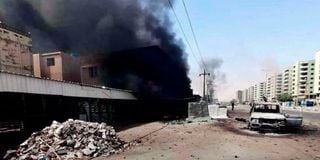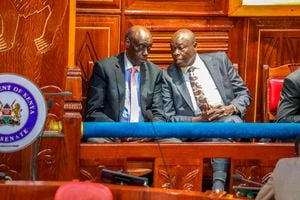Sudan war shouldn’t be our future

This handout photo taken on April 23, 2023, and released on April 24 by the Indonesian Foreign Ministry shows smoke rising from a building next to a damaged car on a street in Khartoum.
Sudan’s capital, Khartoum, is living through a shaky ceasefire in the bloody civil war between the army chief, Gen Abdel Fattah al-Burhan, and his former deputy, Gen Mohamed Hamdan Daglo “Hemedti”, who leads the powerful Rapid Support Forces (RSF) private paramilitary group.
At the time of writing, almost 500 civilians had been killed and more than 2,000 injured. Trapped civilians fled the city, or scrounged for supplies, as foreign nations continued the evacuation of their civilians.
With a population of six million, it is/was Africa’s fifth-largest city. Founded in 1821, Khartoum is also one of the continent’s oldest and most historic cities. However, in a short 10 days of fighting and bombing, a lot of that history has been blown to smithereens.
Only one other African city with such history has been devastated by war in the past few days: Mogadishu, the Somali capital, which some scholarship dates to be 2,170 years older, having been founded in 350 BCE!
The fighting and killings are a tragedy but we should be afraid of much more than that. The Burhan-Hemedti clash is a high point of a new kind of conflict in Africa—wars that begin in capitals.
Most conflicts on the continent, until recently, started in the countryside. The rebels fought their way, sometimes over many years, to the capital and made a grand victorious entry to announce themselves as the new government.
Uganda’s President Yoweri Museveni did exactly that with his National Resistance Army (NRA) rebels in 1986 after fighting in the bushes for five years. In Ethiopia, Meles Zenawi did it in 1991, capturing power in Addis Ababa at the head of the Ethiopian People’s Revolutionary Democratic Front after more than a decade of war in the mountains and hills.
In East Africa, the pattern changed dramatically in South Sudan in December 2013, following a political struggle between President Salva Kiir and Dr Riek Machar that led to the latter’s removal as vice president.
Bitter fighting broke out between their factions in the capital, Juba. But in a few days, it quickly spread upcountry to Jonglei, Upper Nile and Unity states.
Ten years later, nearly 500,000 people have been killed and more than four million displaced, about two million of them internally displaced. Almost three million South Sudanese have fled to neighbouring countries, mostly Uganda and Sudan.
No direct foreign player
The fighting in Juba in December 2013 was, however, nowhere near the scale of what’s happening in Khartoum. Moreover, in Khartoum, there is no direct foreign player on the ground to tilt the scales as Uganda’s quick and ruthless military intervention to save Kiir did in Juba.
Our old wars that started upcountry and came to the city disproportionately affected rural communities, which bore the brunt. However, they gave the elite, diplomats and foreigners in the big city time to put their affairs in order—withdraw their money and move their families abroad, and the embassies could evacuate in a leisurely and more orderly fashion.
Because anything from 50 to 80 per cent of gross domestic product (GDP) in most African countries is produced in the capital and surrounding regions, the old conventional wars that started in faraway bushes did less damage to the economies.
It all begs the question of whether Khartoum is an aberration or the future of violent political conflict in Africa. It’s most likely the future. Africa is the fastest-urbanising continent. Its population is projected to double by 2050 and two-thirds of this growth will be absorbed by urban areas. Within the next 30 years, African cities will be home to an additional 950 million people.
The political contradictions will go where most people are. Kenya is getting a taste of it with the Maandamano cost of living and political protests called by the opposition. They are primarily urban protests. Nairobi is also unique in East Africa in that its suburbs have large concentrations of people from particular national communities, and many are politically monolithic.
We live in a part of Nairobi which was previously Jubilee-dominated and is today ringed by the ruling Kenya Kwanza stronghold. Anti-government protests are things we watch on TV, and life goes on normally as battles rage elsewhere.
In that sense, Nairobi is like the Republic of Congo’s capital, Brazzaville. In 1997, a fight among the political class led to suburbs becoming strongholds, from which they launched a fight for power, and we had all those militias with colourful names like Ninja, Cobra and Coyote.
There is a silver lining, though. When rebel wars take place in the countryside far from the capital, the political class can afford to drag their feet on negotiating an end to the conflict. When it starts in the financial district, and the airport is bombed, they are likely to cut a deal more quickly.
Khartoum will soon clarify all that for us.
Mr Onyango-Obbo is a journalist, writer and curator of the "Wall of Great Africans". @cobbo3





